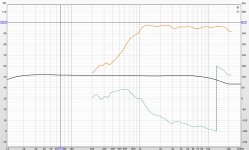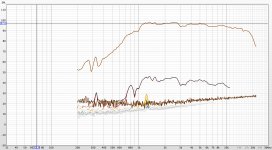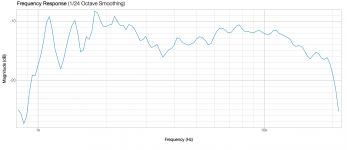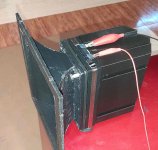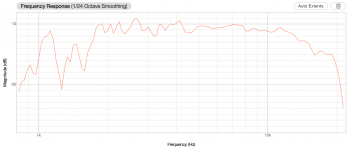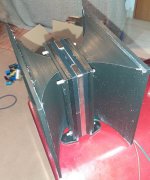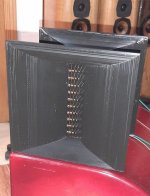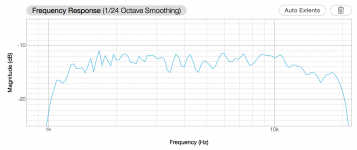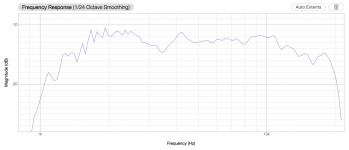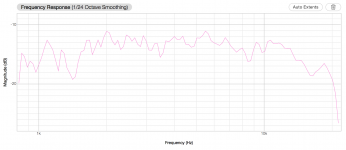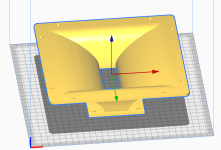Another update. The response and distortion values of the Beyma TPL 150H with Luis Garcia's acoustic filter and the large closed box as described earlier. Calibrated UMIK-1 placed at 20 cm from the baffle plane. There are two attached pictures, one with SPL and Phase, the other one with the Distortion profile.
The measurements are, in my opinion, stunning.
I hereby declare Luis a genius!
The measurements are, in my opinion, stunning.
I hereby declare Luis a genius!
Attachments
The tweeters are Visaton TL-16H. Close to the best Fostex's if you only consider the very top frequencies (where any distortion is actually completely irrelevant).
There is no xo in the sense that there is no low pass on the Beyma, but I put a 2nd order high pass with f3 at roughly 16K on the Visaton. Since the TPL-150H starts decreasing naturally just before 14K
This is wrong by the way. I was measuring with a flat surface (a chair...) behind the mike and therefore there were reflections. I have redone everything properly (with no reflecting surfaces near the microphone) and the Beyma goes flat to almost 20K as shown in my other post. It does go down a bit but not as much as to require a super tweeter.
I therefore removed the Visaton tweeters.
I was able to print Luis' (Oneoclock) notch filters and today I measured the TPL-150H open back (dipole) in-room, sitting where they usually sit (90cm from floor, 1m from absorbent back wall).
Red line is without notch filter, green is with it:
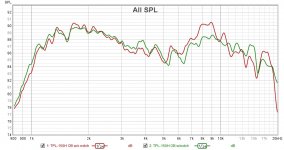
As observed by Oneoclock and Mocenigo, we can see about 3dB reduced SPL from 7.5 to 9kHz and about 1dB increased SPL above 3kHz and past 11kHz. Looks good I think. Haven't been able to do any listening though.
Interestingly, I compared THD from REW:
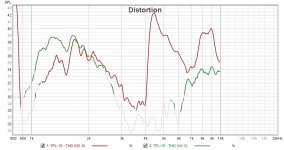
I believe the grayed parts of the line are connected to the noise floor being too high in those areas. However it seems rather clear how THD is reduced with notch filter past 1.7kHz and especially visible above 4kHz. I hope it sounds as it looks here!!
I ended up having 3 prints of the notch filter because the first one had a small defect. Since my TPLs use the factory waveguide in the front and a rough DIY waveguide in the back...I'm going to try and use one notch filter on the front and one on the back and measure. Just for fun.
Thank you Luis!!!!
Amazing work. Can't wait to make a system measurement during the weekend and create new DSP filters and have a listen.
Red line is without notch filter, green is with it:

As observed by Oneoclock and Mocenigo, we can see about 3dB reduced SPL from 7.5 to 9kHz and about 1dB increased SPL above 3kHz and past 11kHz. Looks good I think. Haven't been able to do any listening though.
Interestingly, I compared THD from REW:

I believe the grayed parts of the line are connected to the noise floor being too high in those areas. However it seems rather clear how THD is reduced with notch filter past 1.7kHz and especially visible above 4kHz. I hope it sounds as it looks here!!
I ended up having 3 prints of the notch filter because the first one had a small defect. Since my TPLs use the factory waveguide in the front and a rough DIY waveguide in the back...I'm going to try and use one notch filter on the front and one on the back and measure. Just for fun.
Thank you Luis!!!!
Amazing work. Can't wait to make a system measurement during the weekend and create new DSP filters and have a listen.
Lewinski, why do you have such a dip between 3-7kHz? The response at 5-6kHz is down 6dB compared to 2kHz? I know you use DSP but that’s not a good natural response. It also seems to to differ from Luis’s and Mocenigo’s measured responses under same conditions (acoustical notch filter, open back or larger chamber etc).
Last edited:
I was able to print Luis' (Oneoclock) notch filters and today I measured the TPL-150H open back (dipole) in-room, sitting where they usually sit (90cm from floor, 1m from absorbent back wall).
Red line is without notch filter, green is with it:
View attachment 988427
As observed by Oneoclock and Mocenigo, we can see about 3dB reduced SPL from 7.5 to 9kHz and about 1dB increased SPL above 3kHz and past 11kHz. Looks good I think. Haven't been able to do any listening though.
Interestingly, I compared THD from REW:
View attachment 988428
I believe the grayed parts of the line are connected to the noise floor being too high in those areas. However it seems rather clear how THD is reduced with notch filter past 1.7kHz and especially visible above 4kHz. I hope it sounds as it looks here!!
I ended up having 3 prints of the notch filter because the first one had a small defect. Since my TPLs use the factory waveguide in the front and a rough DIY waveguide in the back...I'm going to try and use one notch filter on the front and one on the back and measure. Just for fun.
Thank you Luis!!!!
Amazing work. Can't wait to make a system measurement during the weekend and create new DSP filters and have a listen.
I am a bit puzzled by the distortion under 2Khz. It should drop by around 20Db in that range as well. Also, make sure you have a very close measurement — such as at 20cm from the plane of the horn mouth — and you see that the response should be much flatter than what you measured. Otherwise, also side walls will alter it. No surfaces behind the microphone, such as chairs, place some foam behind the microphone.
Lewinski, why do you have such a dip between 3-7kHz? The response at 5-6kHz is down 6dB compared to 2kHz? I know you use DSP but that’s not a good natural response. It also seems to to differ from Luis’s and Mocenigo’s measured responses under same conditions (acoustical notch filter, open back or larger chamber etc).
Indeed, this is puzzling and don't know what the reason is. The open baffle is supported by a back vertical column 1" wide, aligned with the AMT, at 12cm from it. It probably produces a cancellation, but doubt it would be such a broad effect as shown in the measurement.
My measurement was done at 16cm from the plane of the waveguide mouth with 3" absorbent (fiberglass/polyfill) placed at the floor 1st reflection point, so I'm thinking floor bounce is not the cause. But then I don't know what it is.
I'll be building a new iteration of the OB without the back vertical column so to remove that factor from the TPL response. Will have to see if the measurement improves. Or measure outside to take the room out of the equation, but that's a hassle...
When measuring my Heil it was surprising how much/little attenuating the back wave had on forward frequency response. It would seem that the amount of resistance imposed at the rear has an effect on the diaphragms movement (linearity). The reflection(s) from your support post may also be a factor.
When measuring my Heil it was surprising how much/little attenuating the back wave had on forward frequency response. It would seem that the amount of resistance imposed at the rear has an effect on the diaphragms movement (linearity). The reflection(s) from your support post may also be a factor.
Are you saying that by removing the back chamber there is now less resistance to back movement and the diaphragm doesn't move as designed, hence the reduced SPL in the middle of the frequency response?
FWIW, I did certainly heard a difference when going from factory back chamber to open baffle, despite both measuring the same due to DSP correction.
The Heil doesn't have a back chamber like your Beyma. What I was surprised by was how the Heil responded to different densities/types of material that I used to attenuate the back wave. I did have the Heil totally enclosed at the back at one point and found that it had limited the low end extension. Upon removing the Heil from the case, the low end response was extended ( about 200hz lower). I can only guess that the additional pressure against the diaphragm worked to limit the forward response.Are you saying that by removing the back chamber there is now less resistance to back movement and the diaphragm doesn't move as designed, hence the reduced SPL in the middle of the frequency response?
FWIW, I did certainly heard a difference when going from factory back chamber to open baffle, despite both measuring the same due to DSP correction.
Experiments with rear wave attenuation showed other response changes higher in frequency. Some worked to smooth the response while others produced peaks and nulls at various points. It became apparent that the material density at the rear of the Heil could be tailored well enough to produce better forward response. Maybe a question of just the right amount of resistance imposed on the diaphragm to even out the natural response (peaks/nulls) tendencies it has.
Was a lot of trial an error. What worked pretty well on these diaphragms was (50mm) "fluffed" thickness of fiberglass, full width/length, just loosely applied to the back side.
Last edited:
The Heil doesn't have a back chamber like your Beyma. What I was surprised by was how the Heil responded to different densities/types of material that I used to attenuate the back wave. I did have the Heil totally enclosed at the back at one point and found that it had limited the low end extension. Upon removing the Heil from the case, the low end response was extended ( about 200hz lower). I can only guess that the additional pressure against the diaphragm worked to limit the forward response.
Experiments with rear wave attenuation showed other response changes higher in frequency. Some worked to smooth the response while others produced peaks and nulls at various points. It became apparent that the material density at the rear of the Heil could be tailored well enough to produce better forward response. Maybe a question of just the right amount of resistance imposed on the diaphragm to even out the natural response (peaks/nulls) tendencies it has.
Was a lot of trial an error. What worked pretty well on these diaphragms was (50mm) "fluffed" thickness of fiberglass, full width/length, just loosely applied to the back side.
Thank you! Very interesting. Mocenigo's TPL was in a large closed box and I think Oneoclock was in a box as well, so maybe it's the open baffle combined with what you are describing?
Tonight I hope to be able to repeat the process and convert the other TPL, and will also try placing something in the back as if closing it to see if there is a change in behavior.
Is your measurement gated and if so which type and length of window?
REW is set to automatic windowing with Tukey 0.25 for left and right, and frequency dependent windowing unchecked.
Indeed, this is puzzling and don't know what the reason is. The open baffle is supported by a back vertical column 1" wide, aligned with the AMT, at 12cm from it. It probably produces a cancellation, but doubt it would be such a broad effect as shown in the measurement.
My measurement was done at 16cm from the plane of the waveguide mouth with 3" absorbent (fiberglass/polyfill) placed at the floor 1st reflection point, so I'm thinking floor bounce is not the cause. But then I don't know what it is.
I'll be building a new iteration of the OB without the back vertical column so to remove that factor from the TPL response. Will have to see if the measurement improves. Or measure outside to take the room out of the equation, but that's a hassle...
I assume you have removed the thick felt on the back?
I assume you have removed the thick felt on the back?
Yes, in all prior measurements the TPL was in dipole and no back felt was in place. In fact nothing but the backwave is behind the membrane.
I did some further work. What I measured before was my right TPL. Now I went onto the left one. Here's are both measured in room, about the same distance from back (absorptive) wall, same height (3" absorption on floor reflection point), both with mic at 16cm, both OB and no notch filter. Both with the back column supporting the baffle:
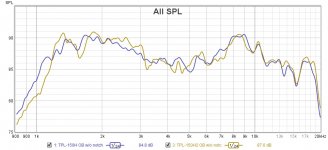
We see the broad trough between 3 and 7kHz approx showing up in both. Important to note the scale, and realizing it's +/- 3dB SPL between 1.1 and 15kHz. Looks uglier than it is, I think.
Left TPL must be having some cancellation at 3kHz explaining the drop. I suspected a measurement table reflection that I later corrected. The peak from 7.5 to 9.5kHz is there in both.
Next I added the notch filter. Since my TPLs are open back, exposing the membrane, I restore the factory back chamber for protection while I install the notch filter, so decided to measure with the factory back chamber in place, for fun:

Awful!!!😕 I thought something was wrong with the measurement and moved on to other measurements since I will use it OB anyway. Later I realized this wasn't wrong and I had not reinstalled the factory back felt that is glued to the TPL steel (the one glued on the back of the chamber was in place). I'm thinking those big cancellations are connected to what puppet pointed to: reduced backwave attenuation, plus a very close back wall created this mess.
I removed the back column supporting the bafffle and replaced with steel Ls on the sides so no effect from wings get in the way, and no reflection from the behind the membrane, and measured the TPL open back without back waveguide nor anything else:
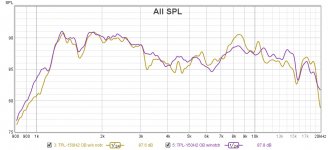
Still +/- 3dB SPL from 1.1 to 15kHz, but smoother. The sharp drop at 3kHz is gone, the peak from 7.5 to 9.5kHz is gone. Response is otherwise about 1dB higher and smoother from 3 to 15khz, except for the trough at 6.3kHz. Definitely looks better than without the notch filter.
Next I reinstalled the back waveguide (note this is a VERY fast and rough DIY experiment, not a nice waveguide!), compared to OB without anything in the back:
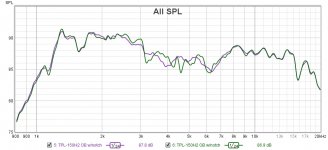
I admit I was expecting to see more gain in the lower range from the waveguide, but there isn't much - at least measured at 16cm. But the drop at 3kHz is back, so it wasn't the misalignment in the measurement table but rather the back waveguide. Also the range between 3 and 6kHz is choppier. Of course this has me thinking next steps regarding the back of the TPL! But the notch filter will be staying!😀
Thoughts about what might be causing the dip at 6.3kHz or the one at 15kHz? I can't hear beyond 15kHz, though😱
Original Beyma horn with filter in a large box. TLP open-back. With a 6.8 uF capacitor.
Not too dissimilar from my measurement. This means that filter, original horn in front and large closed box behind is one of the best loadings of this transducer. I was lucky to try that first, but I also gave it a thought (and there is my bias against dipoles for anything except bass)
Last edited:
- Home
- Loudspeakers
- Multi-Way
- Acoustical notch filter for TPL-150
